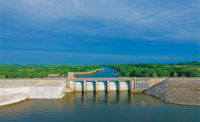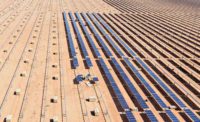Bloom Energy's Red Lion Center






Designed to be the world's highest-output fuel cell power generating facility, the 27-MW Red Lion Energy Center was engineered, procured and built in nine months.
The site represents the largest investment by onsite power developer Bloom Energy, Sunnyvale, Calif., outside of its home state and is the company's first major deal with a power utility. Delmarva Energy provides the natural gas needed to run the fuel cells, which then produce the electricity that Bloom sells back to the utility (see ENR 7/8/13 p. 36).
Despite Bloom's distant headquarters, the team was able to maintain close coordination. Integrated review meetings between the owner, designers and contractors during the design phase led to continually evolving designs that were fully vetted by the client's engineering and manufacturing groups. The team was able to integrate alternatives early in the process, reducing the time and cost of design rework.
Schedule was the driving factor throughout the entire project. Delmarva Energy estimated that planning and engineering alone would take more than a year. Driven by the goal to open the facility and start generating revenue, the team was required to work around the clock to meet the five-day allotted time frame for connection to the substation. The project also included a 200,000-sq-ft Bloom manufacturing plant in Newark, Del., that is part of the University of Delaware's new Science, Technology and Advanced Research (STAR) campus. It is on the site of an old Chrysler assembly plant.
Significant economic incentives were tied to opening the center for commercial operation. The schedule allowed for no slippage in most of the equipment deliveries; fortunately, crews had no weather days that would have caused delays.
Coordination and logistics were complex. Internal and external stakeholders included the client's manufacturing supply chain and internal manufacturing resources, product delivery network, electrical and construction regulators, utility companies, local contractors and material vendors.
The site comprises 135 refrigerator-size Bloom Energy servers—which are grouped in clusters in an open yard—along with a natural gas regulation station and stormwater management systems. Functioning as an industrial site without any permanent building structures, the project highlights the fuel cells' sleek design and their aesthetic appeal—a factor that Bloom uses to market its product to potential clients.
The "Bloom boxes" installed on the site to generate power reduce carbon dioxide emissions by 40% to 100% compared with the U.S. grid and virtually eliminate emissions of sulfur oxide, nitrous oxide and other harmful smog-forming particulates.
Crews tallied 30,000 work-hours with no accidents or OSHA recorded injuries or illnesses. No claims were filed against the project.
Energy/Industrial: Winner - Bloom Energy's Red Lion Center, New Castle, Del.
Key Players
Owner Bloom Energy
Lead Design Firm McBride and Ziegler Civil Engineering
Construction Manager Hill International
Civil Engineer McBride and Ziegler Civil Engineering
MEP Engineer Concord Engineering-Electrical Engineering
Electrical Nickle Electric
Substation Engineer SECO
Transmission Lines Tri-M





